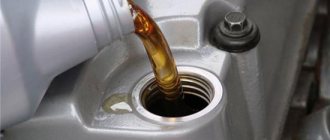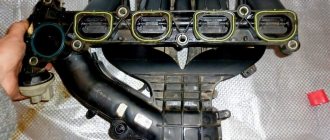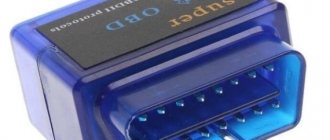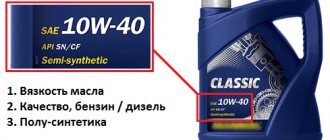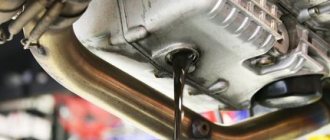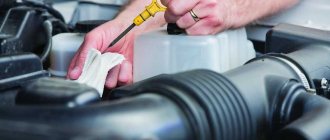Owners of Lada Priora cars often experience increased oil consumption. The role of motor oils in engine operation is very important. One of the main tasks is the formation of a film with low friction coefficients on the surfaces of rubbing surfaces. Lubricating fluids also cool the elements of the piston group and timing mechanism. Oil transports carbon deposits and metal particles to the filter. Many owners would like to know why the Priora consumes oil. Let's look at why this happens and how to fix it.
What is increased consumption
By the term “eating oil”, car owners mean increased consumption of lubricating motor fluids.
Often, during normal operation, such waste should not occur - the standards established by the manufacturer will be observed if there are no problems. If the technical documentation for the car states that replacement should be carried out once every 10 thousand kilometers, and the driver has to top it up more often, then this is an increased consumption.
Conclusion
The choice of oil for the car must correspond to that recommended in the operating instructions. Replace filters in a timely manner and monitor the condition of the coolant.
Be sure to warm up a cold engine, especially in winter. Do not use flushing fluids from unknown manufacturers. With this approach, the heart of your car will work for a long time and without loss of oil.
Died
I love cars in all forms. I've been tinkering under the hood since childhood. I know all the ins and outs of Russian cars and some imported ones. I will be happy to share my knowledge with everyone who likes to do everything with their own hands.
Where does it go?
The correct operation of internal combustion engines largely depends on whether there is a sufficient amount of lubricants inside. Oil, as noted above, is necessary to reduce friction between the rubbing surfaces of parts. The most intense friction is in the parts of the cylinder-piston group. Since high temperatures are constantly maintained in the engine, some of the oil burns out in the cylinders and is then removed along with the exhaust gases. Also, part of the lubricating fluid settles on the cylinder walls, on valve seats, and on oil scraper piston rings.
Increased consumption, complaints from drivers that the Priora is consuming oil - this is a sign that the engine has one or more malfunctions. Most often, the reason is very banal - it is natural wear and tear of the CPG. The first call is oil in the crankcase ventilation system. This happens due to high gas pressure in the crankcase. This pressure will increase as the engine wears out.
How to change the oil mixture in Lada Priora
If the car’s warranty has already expired and there is no need to carry out scheduled maintenance at the dealer, in Lada Priora you can change the engine oil yourself. This process is simple. You just need to follow a certain sequence of actions. You must purchase in advance a 4-liter canister of motor fluid with suitable properties, as well as an oil filter. If you are going to switch to a different viscosity or change manufacturer, you will additionally need to flush the engine.
Soft flushes, according to the conditions of their use, are poured 200–300 kilometers before changing the lubricant. During this time, they clean the engine of toxins. Others pour right before you change the oil. Then the engine idles for 5 minutes to half an hour. It all depends on the specific wash. You should prepare: your own set of wrenches, a container for used lubricant, rags.
- The engine warms up well, the car is placed on a lift or over an inspection hole.
- The filler neck under the hood is released. The drain plug is carefully unscrewed with a 17 key, and a container for draining is first placed in the bottom of the crankcase.
- The old oil is completely drained along with the flush. It is advisable to suck out the remaining lubricant from the bottom with a large syringe with a tube - after all, it is very difficult to park the car in an absolutely horizontal position.
- The old oil filter is unscrewed. A new one is installed, half filled with new grease.
- The drain plug is screwed in and about 3.5 liters of lubricant flows into the engine through the filler neck. The level is checked with a dipstick; it should be halfway between MIN and MAX.
- The engine starts and idles. After 5–7 minutes, the oil level is checked again. Top up if necessary.
Your car is ready to travel again until the next consumable replacement.
Oil consumption rates for Lada Priora
The car can be equipped with one of four engines. Each modification has its own expense. Thus, an 8-valve 1.6-liter engine with a power of 87 horsepower should consume up to 50 grams per thousand kilometers according to standards. The VAZ-21126 model with a power of 98 horsepower should also, according to the manufacturer, have modest appetites. The 1.8 liter model (VAZ-211128) has an oil consumption rate of 300 grams per thousand kilometers.
For 1.6 units, the oil consumption rate does not exceed 50 grams. The latest engine is modernized. Its key features are that with a standard cylinder block, the developers changed the stroke of the pistons by using a different crankshaft and shorter connecting rods. This technical solution led to increased loads on the engine, or more precisely on the pistons, rings, cylinder block walls and connecting rods.
In some cases, if the engine is severely worn out, the Priora consumes up to 3 liters of oil per thousand kilometers. Let's look at the main reasons for increased oil appetite in a car.
Oil waste
The car can “eat” consumables due to burnout. This is due to the fact that the oil indicators do not correspond to the characteristics of a particular engine. An excessively liquid oil product will remain in the cylinder block and burn out. And if it is too thick, it will envelop the moving parts with a dense film, significantly complicating their movement.
All this will lead to increased oil costs. In view of this, you need to use only the lubricant recommended by the car manufacturer.
Severe burnout can occur due to worn valve seals. Identifying this problem is quite difficult. To prevent the lubricant from smoking, that is, to stop burning, the seals need to be replaced. The piston rings also need to be changed. If they wear out significantly, engine repair may be required.
Reasons for increased consumption
Several can be highlighted. The most common is wear of the valve stem seals. They are installed in the gas distribution mechanism.
Problems with caps should be solved very carefully, despite their simplicity. So, these elements are made of rubber - it can harden. This probability increases significantly if the engine does not warm up well. “Priors” with high mileage often suffer from this. The cuff (if it is frozen) will not be able to fit tightly into its seat - because of this, the oil will enter the valve sleeve without any obstacles. As a result, the lubricant will enter the cylinders, where it will burn safely. Oil can also get into the exhaust system. There will be characteristic blue smoke.
Rings
The Priora consumes oil not only because of the caps. The second most common problem is the piston rings. Each of the pistons, and there are four of them in a car engine, has three rings. Two of them are compression, and the third (lowest) is an oil scraper.
Automakers use compression rings to reduce the distance between the piston and cylinder. This ensures maximum energy transfer. To reduce friction, compression rings are lubricated. This oil should then be removed by the oil scraper ring. If the latter is worn out, then it is not surprising that the Lada Priora is burning oil.
If the ring is worn, it will not be able to remove oil from the cylinder walls. As a result, the lubricant will enter the combustion chambers, where it also burns safely.
The car constantly heats up/cools down over its entire service life. Naturally, huge loads fall on every component and part in the engine. If the elasticity or wear of the piston rings has decreased, then this may be the cause of an interesting phenomenon - flutter. Little is known about it yet; this phenomenon has not yet been well studied. But during engine operation, the rings rotate around the piston at certain speeds. In doing so, they can even jump from one edge of the piston groove to the other. In fact, this reason is revealed even more often than ring wear when there are complaints that the Priora burns oil but does not smoke. Although a clear sign of increased oil consumption is blue smoke from the exhaust pipe.
Low quality oils
One of the reasons for increased consumption is the low quality of this same oil or the wrong choice. For each engine, including the Lada Priora, there are certain tolerances. But if you make the wrong choice, your consumption can skyrocket. For example, reduced viscosity can cause the rings to fail and collect lubricant from the cylinder walls. Therefore, the lubricant will settle on the walls of the combustion chamber and, as a result, will burn along with the fuel.
As a result, exhaust gases will come out in the form of bluish smoke, and the oil will settle as soot on the spark plugs. For the same reason, the rings become coked. Oil settles in a very thick layer on engine parts and components.
Troubleshooting Methods
The first thing to do is to find possible leaks by carefully inspecting the valve cover. If there are leaks on the engine oil pan, drain the oil, then unscrew the pan and change its gasket, preferably placing it on sealant. If there is a leak through the crankshaft seals, replacing them yourself will be very problematic. It is better to carry out repairs at a service station.
Another reason for increased consumption may be a clogged crankcase ventilation system. Over time, resin deposits and carbon products are deposited on the walls of the pipe, which makes it difficult to remove gases that have escaped from the combustion chamber. This creates excess pressure in the crankcase, which forces oil through the seals and seals. Oil mist will enter the combustion chamber in excess through the ventilation system and intake manifold, which will lead to a decrease in the calorific value of the fuel and loss of engine power. To prevent this problem, it is necessary to regularly clean the ventilation system pipes: approximately every 50 thousand kilometers.
You should be careful about the quality of the lubricants used. They must comply with those recommended by the manufacturer, taking into account the climatic zone of the vehicle's operation. By following all the necessary recommendations, eliminating the indicated malfunctions and abandoning an aggressive driving style, you can significantly reduce the consumption of fuel and lubricants in your car.
Natural wear and tear
If the Priora engine consumes oil, then most likely the engine has a high mileage, and the reason for oil consumption is the natural wear and tear of the engine itself and its individual components. As a result, oil will be consumed much faster than during normal operation. Engine wear can also be the cause of cylinder deformation, cracks, gasket burnout, and failure of engine seals. Motor oils can be deposited in engine parts and components, but it can be difficult to determine how large the excess consumption is. It depends on how worn out the engine and other systems in the car are.
Reason #1
If, after the engine has been idling for several minutes, you press the gas pedal to the floor several times, a thick cloud of bluish smoke may escape from the chimney. As the number of presses increases, the smoke will disappear, but this is one of the signs of engine malfunction. The reason is the valve stem seals.
An oil leak while the engine is running in idle mode and then its sudden combustion in the cylinders leads to the appearance of this thick smoky cloud and an increase in oil consumption. But replacing the caps cannot always solve this problem. Sometimes, if a Priora consumes oil, the reasons may be in the valve bushings. Experts recommend changing them along with the valve stem seals.
The engine eats engine oil, but does not smoke: what is the reason
If there really is no smoke, then the conclusion suggests itself - the lubricant does not burn out, but goes away. There are plenty of joints in the engine from which fluid under pressure can leak. This can be as small as a loose drain plug, or something more serious - for example, a sweaty valve cover. It is also possible that there is a leak, but there are no traces of it outside.
To make diagnosis easier, let’s divide all the symptoms into two groups:
- Clear leakage. When inspecting the engine compartment or area under the car, clear oily stains are found.
- Implicit leak. There are no external signs, it becomes noticeable only after dismantling a number of parts.
The leak location is clearly visible
The conclusion that there is a leak somewhere is usually made based on an inspection of a long-term parking area. Confirmation of this is oil traces under the engine. To make it more convincing, you can put a sheet of white cardboard. This will help determine the color of the liquid, and therefore find out which system has a problem. For example, a red or green spot indicates that the hydraulic booster (power steering) is leaking.
Obvious leak points include the following connections:
- Cylinder head valve cover. To seal this joint, either rubber gaskets or sealant are used. The connection is quite capricious. For example, the cuff must be changed after each disassembly, and the sealant rarely lasts longer than 5 years.
- Cylinder block-sump. There is a rubber gasket installed here.
- Engine oil filter housing. A year earlier, we looked at why oil squeezes out from under the air filter on various engines. As a short summary, we present the following fact: oil can leak from this joint under the pretext of one of 7 reasons.
- Oil pressure sensor. Clamp the part and the leak will go away.
There are no traces of lubrication, but the oil is leaving
The situation is such that the engine compartment is clean, there are no stains under the car, and the dipstick clearly shows the sagging level of lubricant. The list of diagnostic actions in this situation is as follows:
- Look into the spark plug wells. For example, oil in the spark plug well of Lada Priora and Lada Granta with 16-valve engines leads to serious consequences. So, the ignition coil ends up in liquid and fails. This also threatens foreign cars, since there is no fundamental difference between “injectors” with 4 valves per cylinder.
- Remove the timing belt cover. Pay attention to the crankshaft and camshaft seals. Even a slightly sweaty rubber band needs to be changed.
For your information. A rubber-fabric timing belt is prone to rupture when exposed to oil.
Reason #2
Sometimes smoke appears when climbing a hill, because you have to constantly press the pedal. The driver may not see the smoke, but those driving behind will see everything perfectly. A thin stream of smoke is a sign of malfunctions in the piston system, as well as increased oil consumption.
Most often, malfunctions are associated with wear of the piston rings and grooves on the piston for the rings. Also, the rings can lie down and, as a result, their properties are lost. If the compression rings are not positioned correctly due to carbon deposits, this is also one of the faults that causes blue smoke.
Cylinders can also fail. This leads to a decrease in compression. This problem can only be solved with the help of a major overhaul - sleeve or boring. If the pistons fail, the problem can be solved by purchasing and installing new ones.
Many novice car owners ask experienced ones what to do, the Priora is burning oil. You can try using engine decarbonizers.
With the help of special means, the coke is cleared from the rings, and they can become mobile again. Previously, for this, acetone diluted with oil and kerosene was poured into the cylinders. The mixture was then left for a day and then the oil was changed. If this solution does not help, then you can try a miracle drug from the pharmacy - dimexide. This medicine will clear away any carbon deposits and coke.
Should I change the oil if the consumption is high?
Often, car owners, after identifying increased consumption, ask themselves the same question - do they need to change the oil completely every time or is it enough to add fluid from time to time as consumption occurs? Some motorists believe that it makes no sense to perform a complete oil change in this case. During the period, the same amount of lubricant will pass through the engine as if a replacement were being performed.
A complete replacement, in fact, must be carried out in accordance with technical service books and documents. The main function of oil is to reduce friction between rubbing parts and clean the engine. Debris settles in the pan or in the oil filter. But dirt is not removed from the engine. During operation, the amount of carbon deposits will increase, and constantly adding new oil will only compensate for the amount of dirty oil.
Such a liquid will always have a dark color. Therefore, it needs to be changed every 10 thousand, and together with the filter. Otherwise there is a risk of coking.
